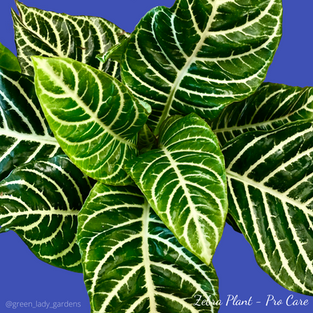Zebra Plant Care
- Green Lady Gardens
- Mar 26, 2021
- 2 min read
Updated: Nov 17, 2023
Aphelandra squarrosa, commonly known as zebra plant, is stunning, exotic, and, we will be honest, high maintenance. But so are calatheas and most ferns, which we all still love, buy, and practice with. And unlike calathea and picky ferns, zebra plants are fairly resilient. Even if you lose every leaf, there is a high probability you can revive it. They also love being chopped back, which is a good starting over point. Best part, if you get it right, you will be rewarded with an epic bloom.
It helps tremendously when you get the correct care information before diving in to more finicky plants. We created this slideshow to provide just that because we know that with this info, a little patience, and some practice, zebra plant could easily become your favorite.
If you love calathea, you'll love this plant. If you don't love calathea, give zebra plant a try. It's worth it.
Save this slideshow from our Instagram account & easily share it with others.
Cover photo credit: Trees.com (see slideshow for direct link.)
Light
Bright indirect light. Too much = Leaves dry, brown, crinkle, & fall off
Humidity
High! 60-70%. Increase with a pebble tray or humidifier. Do not mist. Water gets trapped on textured leaves, causing leaf spot disease. Low humidity = Brown spots, leaf drop.
Water
Prefers damp but not soggy soil. When soil is dry to the touch, water thoroughly until it runs through the pot. Bottom watering can oversaturated the soil & lead to root rot. Overwatering & underwatering = Leaves brown, droop, & drop.
Blooming
The yellow bract is stunning & lasts several months. Flowers from the bract last a few days. Remove bract as soon as it dies or lower leaves will drop. Afterward, move plant to a cooler location & reduce watering for 6-8 weeks so it can rest. Blooming requires rest/dormancy, & a perfect combo of temperature, water, humidity, & feeding. Practice makes perfect so be patient!
Soil & Potting
African violet soil retains water yet drains well. Don't rush to repot. They do fine root bound but not when over potted. Drainage holes aid in providing big drinks in between smaller sips.
Fertilizer
Feeding every 1-2 weeks during the spring & fall is required to produce blooms.
Temperature
Warm! Ideally 65-80°. Lower temps = Leaf drop. Higher temps = Leaves brown & drop.
Pruning
Cut back after bract dies (or at the end of the fall if it does not bloom) to promote spring bushiness & better health.























Comments